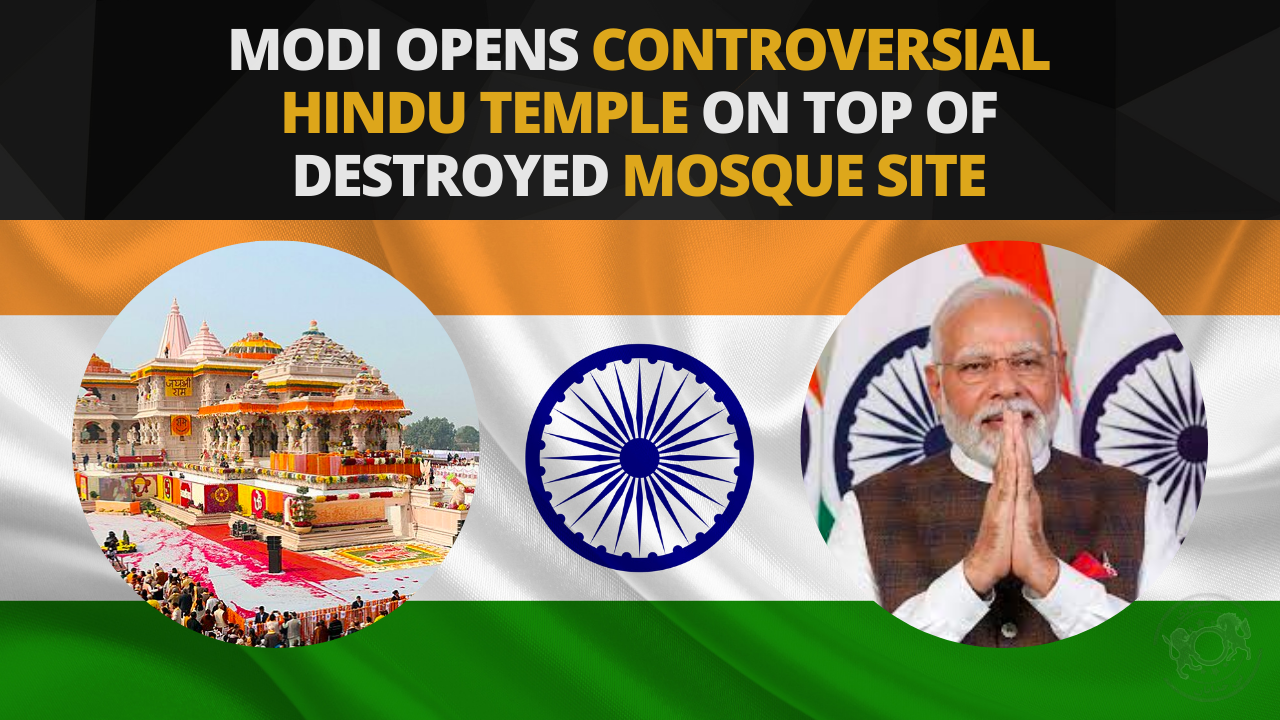
From a Mughal-era mosque that was razed by radical Hindu nationalist militants more than three decades ago, India’s Prime Minister Narendra Modi has inaugurated a newly constructed and highly anticipated Hindu temple that was built in the former mosque’s place, drawing both support and criticism from various groups and sectors of Indian society.
NPR: India's Modi inaugurates a long-promised but controversial Hindu temple in Ayodhya https://t.co/47r8d9zlj4
— xalfeed (@xalfeed) January 22, 2024
Modi led the consecration of the controversial Ram Mandir temple on January 22nd in the northern Indian town of Ayodhya. He capped the ceremony with the unveiling of a 51-inch black stone idol of the Hindu god Ram, a highly revered deity in Hinduism and one of the most popular avatars of the Hindu god Vishnu, in the temple’s inner sanctum. He called the temple’s consecration “the dream that many have cherished for years.”
At the Prana Pratishtha, rituals were performed to consecrate the temple and give blessings and offerings to the idol of the young Lord Ram. Modi took on a leading role, having spent 11 days observing a special purification ritual to prepare.
The temple’s inauguration is a hugely significant religious moment for India. It also marks the culmination of a decades-long dispute over the site that Hindus believe to be the birthplace of their Lord Ram. Many Hindus consider the temple’s construction as Lord Ram returning to his rightful place, a site where a 16th-century Mughal-era mosque once stood until its demolition in 1992.
Ram Mandir was built on the site where the Babri Masjid, a mosque constructed in 1528 by Mughal commander Mir Baqi under the rule of Babur, the first Mughal emperor, once stood. Disputes over the site began when a Hindu sect claimed in 1853 that a Hindu temple was destroyed during Babur’s reign to make way for the mosque.
These conflicts continued well into the 20th century when the newly independent India declared the mosque a “disputed property” after a small group of hardline Hindu priests placed an idol of Lord Ram inside the structure. No Muslim prayers were offered after that, and the mosque was locked.
Nevertheless, the dispute over the site reached its turning point when a mob of Hindu nationalists, encouraged by leaders of Hindutva groups such as the Bharatiya Janata Party (BJP), marched to the Babri Masjid in Ayodhya and tore down the structure using sledgehammers, axes and iron rods on December 6th, 1992, destroying the mosque in a couple of hours.
Communal violence then broke out across India, which left more than 2,000 people dead, most of whom were Muslims. While the Supreme Court of India ruled in 2019 that the destruction of the Babri Masjid was illegal, it also ruled in favor of the Hindu side. It stated that the land must be handed over to a trust to oversee the construction of a Hindu temple. The court also awarded a separate piece of land in Ayodhya to Muslim groups to construct a new mosque.
The mosque’s demolition, the subsequent construction of the Ram temple in 2020, and Modi laying the foundation stone for the temple also paved the way for Hindu nationalism to grow and become the dominant ideology in India today, and the promise to build a new temple for Lord Ram has been at the core of the BJP’s political agenda.
Hindu supremacists celebrating Ram Temple inauguration in New Delhi!pic.twitter.com/tHtvei8zoO
— Ashok Swain (@ashoswai) January 22, 2024
The inauguration of Ram Mandir was not only a fulfillment of a dream by many Hindu nationalists but also boosted BJP’s electoral fortunes ahead of the upcoming general elections this year, where Modi is expected to take an unprecedented third term in office as Prime Minister.
Many political analysts say the consecration of the $ 220-million temple, which is not yet finished and is expected to wrap up within a year and a half, was performed to showcase the temple as an achievement of the BJP by fulfilling its pledge to build a long-promised temple in Ayodhya ahead of the general elections, which will take place this spring.
The temple’s consecration became a national event, with 8,000 official guests ranging from politicians, diplomats, and Bollywood stars to holy figures present during the inauguration. Hundreds of thousands of pilgrims also flocked to the temple to show their devotion to Lord Ram.
Many critics and opposition leaders denounced and even boycotted the event, accusing Modi of using the temple’s consecration for political gain while also signaling the fast-eroding secularism in India.
Members of the Hindutva mob live-streamed their brutality on social media as Ram Temple's inauguration-related violence remains out of control in Mumbai's Mira Road for the second day.
Watch: pic.twitter.com/M7GHnmIPhu
— Maktoob (@MaktoobMedia) January 23, 2024
“This is a purely political spectacle, the culmination of a 40-year political project – one that has been achieved through great violence,” Kapil Komireddi, the author of Malevolent Republic: A Short History of New India, said. “It is the coronation of Hinduism as India’s state religion and the crowning moment for the cult of personality erected around Modi. I see this as a very sad moment for India.”
"The idea is to assert Hindu supremacy," Ziya Us Salam, a veteran journalist at the Indian daily The Hindu and author of Being Muslim in Hindu India, said. "There is one religion which is supreme in the country, and everybody else who is a non-follower of that religion is reduced to the status of a second-class citizen."
The following day, The Wire reported about 300 young men caused havoc in Mumbai, pelting stones and destroying Muslim shops and property. It is alleged that officers from the Naya Nagar police station were present and refused to stop the mob.
Also attacked were a tempo driver, a man at a mobile shop, and a 16-year-old boy, according to the report. Four FIRs were filed concerning the events.
